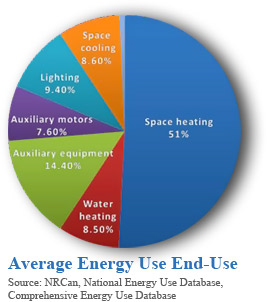The main energy consuming activities in a hotel are:
heating rooms,
cooling rooms,
lighting,
hot water use and other energy consuming activities by guests,
preparing meals (especially warm ones),
swimming pool, other sport and health activities
For most hotels, energy use falls in the range 200-400 kWh/m2/yr. A “meta-analysis” (combining data from all the various studies) suggests that average energy use by hotels is in the range 305-330 kWh/m2/yr.
The relative importance of the different energy end-uses is described as follows:
- Space conditioning (heating/cooling, ventilation and air-conditioning) is the largest single end-user of energy in hotels, accounting for approximately half of the total consumption – it is thus widely accepted that outdoor weather conditions and floor areas are among the main factors affecting energy use in hotels. The indoor temperature levels also greatly influence the quantity of energy consumed in a building.
- Domestic hot water is commonly the second largest user, accounting for up to 15 per cent of the total energy demand.
- Lighting can fluctuate between a range of 12-18 per cent and up to 40 per cent of a hotel’s total energy consumption, depending on the category of the establishment.
- Services such as catering and laundry also account for a considerable share of energy consumption, particularly considering that they are commonly the least energy-efficient.
- Sports and health facilities are typically high energy consumers.
Studies in USA indicate that on average, America’s 47,000 hotels spend for energy $2,196 per available room each year on energy. This represents about 6 percent of all operating costs.
Various studies have estimated that hotels have the potential to save at least 10 – 15 per cent of the energy they consume, depending on the age and size of the hotel, as well as type of equipment installed and the maintenance and operating procedures in use.
An assessment of potential energy conservation in southern European hotels revealed that there is a potential for 25 – 30 per cent energy savings, especially in hotels with high annual energy consumption.
European studies have estimated savings of 15 – 20 per cent for heating, 5 – 30 per cent for cooling, 40 – 70 per cent for hot water and 7 – 60 per cent for lighting.
